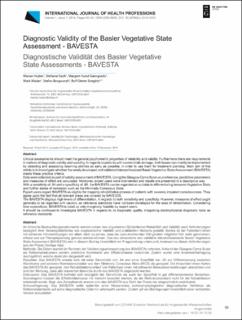Please use this identifier to cite or link to this item:
https://doi.org/10.21256/zhaw-4375Full metadata record
| DC Field | Value | Language |
|---|---|---|
| dc.contributor.author | Huber, Marion | - |
| dc.contributor.author | Koch, Stephanie | - |
| dc.contributor.author | Hund-Georgiadis, Margret | - |
| dc.contributor.author | Mäder, Mark | - |
| dc.contributor.author | Borgwardt, Stephan | - |
| dc.contributor.author | Stieglitz, Rolf-Dieter | - |
| dc.date.accessioned | 2019-03-20T15:08:32Z | - |
| dc.date.available | 2019-03-20T15:08:32Z | - |
| dc.date.issued | 2014-12 | - |
| dc.identifier.issn | 2296-990X | de_CH |
| dc.identifier.uri | https://digitalcollection.zhaw.ch/handle/11475/16209 | - |
| dc.description.abstract | Introduction: Clinical assessments should meet the general psychometric properties of reliability and validity. Furthermore there are requirements in matters of diagnostic validity and usability. In regards to patients with severe brain damage, both issues can mainly be implemented by detecting and assessing returning abilities as early as possible, in order to use them for treatment planning. Main aim of this article is to investigate whether the newly developed and validated interprofessional Basel Vegetative State Assessment (BAVESTA) meets these practice criteria. Method: Data were collected as part of validity assessment of BAVESTA. Using the Glasgow Coma Scale as a reference, predictive parameters and measures of effect are calculated. Moreover, expert users were interviewed and results are presented in a descriptive way. Results: With a sensitivity of 0.84 and a specificity of 0.85, the BAVESTA can be regarded as suitable in differentiating between vegetative state and further states of remission such as the minimally conscious state. Expert users regard BAVESTA as eligible for mapping rehabilitative process of patients with severely impaired consciousness. They agree upon the fact that all relevant areas are covered by BAVESTA. Discussion: The BAVESTA displays high levels of differentiation, in regards to both sensitivity and specificity. However, measures of effect ought generally to be regarded with caution, as reference standards have not been developed for the area of rehabilitation. Considering time expenditure, BAVESTA is rated as only marginally feasible by expert users. It should be continued to investigate BAVESTA in regards to its diagnostic quality, integrating electrophysical diagnostic tools as reference standards. | de_CH |
| dc.language.iso | de | de_CH |
| dc.publisher | De Gruyter | de_CH |
| dc.relation.ispartof | International Journal of Health Professions | de_CH |
| dc.rights | http://creativecommons.org/licenses/by-nc-nd/4.0/ | de_CH |
| dc.subject | Vegetative state | de_CH |
| dc.subject | Interprofessional | de_CH |
| dc.subject | Assessment | de_CH |
| dc.subject | Wachkoma | de_CH |
| dc.subject | Apallisches Syndrom | de_CH |
| dc.subject | minimally conscious state | de_CH |
| dc.subject | Rehabilitation | de_CH |
| dc.subject | Screening | de_CH |
| dc.subject | Sensitivität | de_CH |
| dc.subject | Spezifität | de_CH |
| dc.subject.ddc | 616.8: Neurologie und Krankheiten des Nervensystems | de_CH |
| dc.title | Diagnostische Validität des Basler Vegetative State Assessments - BAVESTA | de_CH |
| dc.title.alternative | Diagnostic validity of the Basler Vegetative State Assessment - BAVESTA | de_CH |
| dc.type | Beitrag in wissenschaftlicher Zeitschrift | de_CH |
| dcterms.type | Text | de_CH |
| zhaw.departement | Gesundheit | de_CH |
| dc.identifier.doi | 10.21256/zhaw-4375 | - |
| dc.identifier.doi | 10.2478/ijhp-2014-0004 | de_CH |
| zhaw.funding.eu | No | de_CH |
| zhaw.issue | 1 | de_CH |
| zhaw.originated.zhaw | Yes | de_CH |
| zhaw.pages.end | 60 | de_CH |
| zhaw.pages.start | 50 | de_CH |
| zhaw.publication.status | publishedVersion | de_CH |
| zhaw.volume | 1 | de_CH |
| zhaw.publication.review | Peer review (Publikation) | de_CH |
| Appears in collections: | Publikationen Gesundheit | |
Files in This Item:
| File | Description | Size | Format | |
|---|---|---|---|---|
| 2014_Huber_M_Diagnostische_Validität_des_Basler_Vegetative_State_Assessments_BAVESTA.pdf | 561.69 kB | Adobe PDF |  View/Open |
Show simple item record
Huber, M., Koch, S., Hund-Georgiadis, M., Mäder, M., Borgwardt, S., & Stieglitz, R.-D. (2014). Diagnostische Validität des Basler Vegetative State Assessments - BAVESTA. International Journal of Health Professions, 1(1), 50–60. https://doi.org/10.21256/zhaw-4375
Huber, M. et al. (2014) ‘Diagnostische Validität des Basler Vegetative State Assessments - BAVESTA’, International Journal of Health Professions, 1(1), pp. 50–60. Available at: https://doi.org/10.21256/zhaw-4375.
M. Huber, S. Koch, M. Hund-Georgiadis, M. Mäder, S. Borgwardt, and R.-D. Stieglitz, “Diagnostische Validität des Basler Vegetative State Assessments - BAVESTA,” International Journal of Health Professions, vol. 1, no. 1, pp. 50–60, Dec. 2014, doi: 10.21256/zhaw-4375.
HUBER, Marion, Stephanie KOCH, Margret HUND-GEORGIADIS, Mark MÄDER, Stephan BORGWARDT und Rolf-Dieter STIEGLITZ, 2014. Diagnostische Validität des Basler Vegetative State Assessments - BAVESTA. International Journal of Health Professions. Dezember 2014. Bd. 1, Nr. 1, S. 50–60. DOI 10.21256/zhaw-4375
Huber, Marion, Stephanie Koch, Margret Hund-Georgiadis, Mark Mäder, Stephan Borgwardt, and Rolf-Dieter Stieglitz. 2014. “Diagnostische Validität des Basler Vegetative State Assessments - BAVESTA.” International Journal of Health Professions 1 (1): 50–60. https://doi.org/10.21256/zhaw-4375.
Huber, Marion, et al. “Diagnostische Validität des Basler Vegetative State Assessments - BAVESTA.” International Journal of Health Professions, vol. 1, no. 1, Dec. 2014, pp. 50–60, https://doi.org/10.21256/zhaw-4375.
Items in DSpace are protected by copyright, with all rights reserved, unless otherwise indicated.